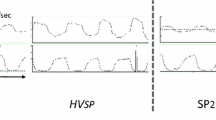Abstract
This study was designed to evaluate the long-term effects of paced diaphragmatic breathing on subjects who reported functional cardiac symptoms and who also demonstrated associated signs of hyperventilation syndrome. Subjects were a representative sample composed of 10 out of the original 41 subjects who had participated three years previously in a study designed to evaluate the short-term effects of breathing retraining on functional cardiac symptoms and respiratory parameters (respiratory rate and end-tidal carbon dioxide). The results of this follow-up study indicate that breathing retraining had lasting effects on both respiratory parameters measured. Subjects evidenced significantly higher end-tidal carbon dioxide levels and lower respiratory rates when compared to pretreatment levels measured three years earlier. Subjects also continued to report a decrease in the frequency of functional cardiac symptoms when compared to pretreatment levels. We conclude that breathing retraining has lasting effects on respiratory physiology and is highly correlated with a reduction in reported functional cardiac symptoms.
Similar content being viewed by others
References
Bass, C., Gardner, W., & Jackson, G. (1989). Abnormal breathing patterns associated with angina-like chest pain.British Journal of Clinical Practice, January, 25–27.
Beck, J., Berisford, M., & Taegtmeyer, H. (1991). The effects of hyperventilation on patients with chest pain without coronary artery disease.Behaviour Research and Therapy, 29, 611–621.
DeGuire, S., Gevirtz, R., Kawahara, Y., & Maguire, W. (1992). Hyperventilation syndrome and the assessment of treatment for functional cardiac symptoms.The American Journal of Cardiology, 70, 673–677.
Evans, D., & Lum, C. (1977). Hyperventilation: an important cause of pseudoanginaLancet, 1, 155–157.
Freeman, L., & Nixon, P. (1985). Mechanisms of disease: Update. Chest pain and the hyperventilation syndrome—some aetiological considerations.Post Graduate Medical Journal, 61, 957–961.
Freeman, L., Conway, A., & Nixon, P. (1986) Heart rate response, emotional disturbance and hyperventilation.Journal of Psychosomatic Research 30, 429–436.
Fujii, H., Yasue, H., Okumura, Matsuyama, K., Marikami, Y., Miyagi, H., & Ogawa, H. (1988). Hyperventilation-induced simultaneous multivessel coronary spasm in patients with variant angina: Echocardiographic and arteriographic study.Journal of the American College of Cardiology, 15, 1184–1192.
George, D., Nutt, D., Walker, W., Porges, S., Adinoff, B., & Linnoila, M. (1989). Lactate and hyperventilation substantially attenuate vagal tone in normal volunteers.Archives of General Psychiatry, 46, 153–156.
Hegel, M., Abel, G., Estscheidt, M., Cohen-Cole, S., & Wilmer, C. (1989). Behavioral treatment of angina-like chest pain in patients with hyperventilation syndrome.Journal of Behavior Therapy and Experimental Psychiatry, 20 31–39.
Kask, J., Crea, F., Meran, D., Rodriguez, L., Araujo, L., Chierchia, S., Davies, G., & Maseri, A. (1986). Local coronary supersensitivity to diverse vasoconstrictive stimuli in patients with variant angina.Circulation, 74, 1255–1265.
Lewis, B. (1959). Hyperventilation syndrome a clinical and physiological evaluation.California Medicine, 91, 121–126.
Magarian, G., & Hichman, D. (1986). Noncardiac causes of angina-like chest pain.Progressive Cardiovascular Disease, 29, 65–80.
Mullins, G., Taylor, G., Petch, M., & Schofield. (1993). Effect of hyperventilation and mental stress on coronary blood flow in syndrome X.British Heart Journal, 69, 516–523.
Takaoka, K., Yasue, H., & Horio, A. (1988). Possible role of coronary spasm in acute myocardial infarction precipitated by hyperventilation.British Heart Journal, 59, 256–258.
Tanaka, H., Yasue, H., Yoshimura, M., Morita, E., Jougasaki, M., Kato, H., Miyao, Y., & Nakao, K. (1993). Suppression of hyperventilation-induced attacks with infusion of atrial natriuretic peptide in patients with variant angina pectoris.The American Journal of Cardiology, 72, 128–133.
Wheatley, C. (1975). Hyperventilation syndrome: A frequent cause of chest pain.Chest, 68, 195–199.
Yasue, H., Nagao, M., Omote, S., Takizawa, A., Miwa, K., & Tanaka, S. (1978). Coronary arterial spasm and prinzmetal's variant form of angina induced by hyperventilation and tri-buffer infusion.Circulation, 58, 56–62.
Yu. P., & Yim, B. (1959). Stanfield A. Hyperventilation syndrome: changes in electrocardiogram, blood gases and electrolytes during voluntary hyperventilation; possible mechanisms and clinical implications.Archives of Internal Medicine, 103, 902–913.
Author information
Authors and Affiliations
Additional information
We would like to thank the Marquette Company for the use of their end-tidal CO2 equipment. We also thank the Biofeedback Institute of San Diego for supporting this study by providing office space and equipment. Steven DeGuire, Ph.D. is now affiliated with Heather Hill Hospital Health and Care Center in Chardon, Ohio.
Rights and permissions
About this article
Cite this article
DeGuire, S., Gevirtz, R., Hawkinson, D. et al. Breathing retraining: A three-year follow-up study of treatment for hyperventilation syndrome and associated functional cardiac symptoms. Biofeedback and Self-Regulation 21, 191–198 (1996). https://doi.org/10.1007/BF02284695
Issue Date:
DOI: https://doi.org/10.1007/BF02284695




